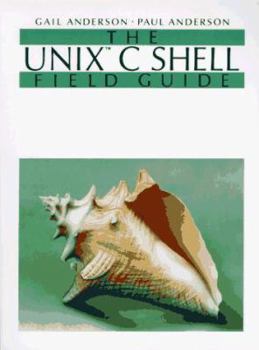The Unix C Shell Field Guide
In-depth study of the C shell as a command interpreter and the gateway to other programs and utilities running under UNIX. This description may be from another edition of this product.
Format:Paperback
Language:English
ISBN:013937468X
ISBN13:9780139374685
Release Date:January 1986
Publisher:Prentice Hall
Length:596 Pages
Weight:1.25 lbs.
Dimensions:0.8" x 7.0" x 9.2"
Customer Reviews
5 ratings
Indispensable if you are starting out.
Published by Thriftbooks.com User , 17 years ago
When I first started writing shell scripts, I found myself referring to this book constantly - and I do mean CONSTANTLY. Simple straightforward explanations and lots of examples. I had 2-3 other books that all wound up gathering dust while this one just kept getting thumbed through. I wrote all kinds of software for over thirty years on everything from embedded microprocessors to giant number crunchers. This was one of the most helpful books I ever used in any of those milieus.
The definitive guide to the C Shell
Published by Thriftbooks.com User , 18 years ago
The C shell (csh) is a Unix shell developed by Bill Joy for the BSD Unix system. It was originally derived from the 6th Edition Unix /bin/sh, the predecessor of the Bourne shell. Its syntax is modeled after the C programming language. The C shell added many feature improvements over the Bourne shell, such as aliases and command history. Today, the C shell is not widely used because it has been superceded by other shells such as the Tenex C shell (tcsh), the Korn shell (ksh), and the GNU Bourne-Again shell (bash). The C shell's scripting capability came under criticism in the early-to-mid 1990s for its ambiguity, especially with respect to quoting and redirection. An example of possibly unwelcome behavior of csh scripts is the following: if ( ! -e foo ) echo bar > foo <br />It would appear to say "if file 'foo' does not exist, create it with contents 'bar'". But it will in fact create an empty file, as the line is parsed such that the output redirect is set up before the file existence is tested. However, if you are a big fan of the C Shell or legacy code has forced you to deal with it, this is the definitive guide to it, even if it is 20 years old. The book is organized as follows: <br />Chapters 1 and 2 introduce the shell. Chapter 1 discusses what it is, what it does, and how you use it. Chapter 2 gives a brief tour of the shell with a sample terminal session. <br />Chapters 3 through 6 present the C Shell as an interactive command language. Chapter 3 presents the C shell's basic command forms. Chapter 4 shows the C shell's power - its command shorthand. Chapter 5 shows how to juggle your commands using job control. Chapter 6 covers the history and alias mechanisms, which are the C shell's original claims to fame. <br />Chapters 7 and 8 present the shell as a programming language. Chapter 7 covers the basic language forms and Chapter 8 discusses more advanced techniques. Both chapters contain plenty of example scripts. <br />Chapter 9 shows how to customize the C shell to accommodate your terminal type, working habits, login/logout procedures, and custom commands. <br />Chapter 10 explains how the C shell works and how it interfaces to the UNIX system. Included are plenty of diagrams to illustrate just how the C shell executes commands. <br />Finally, chapter 11 is a collection of C shell scripts that illustrate a particular technique, perform an interesting task, or solve a problem. Most are actual scripts in use on production UNIX systems at the time this book was printed. <br />This book should be on the shelf of anyone who must work with the C shell on a regular basis. <br /> <br />
Excellent C Shell Book
Published by Thriftbooks.com User , 24 years ago
This book has a nice layout. The first ten pages include a reference for several unix commands which are the foundation for solid scripts. The rest of the book has nice examples that are well written. You create basic scripts that are enhanced as you learn more material. You need to change the first line to !#/bin/csh to run the scripts. I wish the author's would create a newer edition of this book.
The best book on unix shell programming I've read.
Published by Thriftbooks.com User , 24 years ago
I've used this book both as a beginner to unix and as a unix system programmer 10 years later. I would not do shell programming without it and an appropriate O'Reilly 'Unix in a nutshell' book. It is designed to be read end to end, introducing new topics bit by bit and expanding on them using numerous excellent examples which grow in complexity as the book progresses. This does give rise to my one complaint which is that while it is filled with useful tables and charts detailing various command options, etc., it can be difficult to find a particular table using the index since topics are spread throughout the book. Desipite this minor agravation, this book is in my list of 'top 10' must have unix programming books.
If you like lots of excellent examples, this is your book
Published by Thriftbooks.com User , 25 years ago
This is the best C shell book that I have ever come across. Lots of excellent examples and very thorough. This book has been in print since 1986 and there's good reason for it's longevity.




